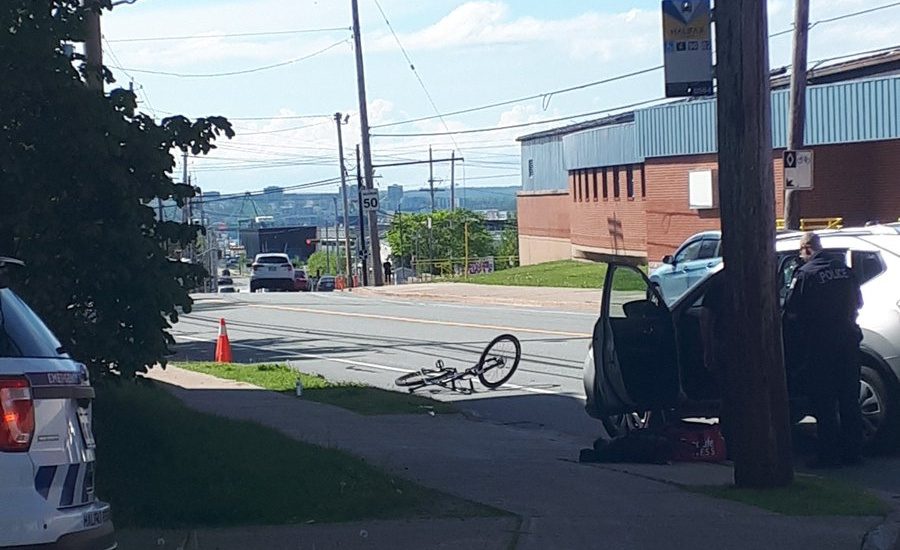
KJIPUKTUK (Halifax) – A horrific few weeks for local cyclists underlines the need for us to review how and where we are delivering safe infrastructure for vulnerable road users.
Yesterday, a cyclist reported he was hit from behind by a vehicle as he waited at traffic lights on Robie Street where it intersects with Almon Street. Robie has five traffic lanes at this point, but no cycle lane.
The day before, a cyclist was hit by a driver reported to be turning off from Windsor Street into underground parking.
And just a few weeks ago, a cyclist seriously injured by a turning truck at the intersection of Windmill Road and Geary Street.
Although we don’t know all the details of how and why these accidents happened, in these kind of scenarios there is often little to nothing you can do as a cyclist to avoid drivers approaching from your rear and either not stopping, or turning into your path.
Halifax’s approach to designing infrastructure for vulnerable road users involves providing safe routes in limited locations. For example a crosswalk every 300 or so metres across a busy road. For cyclists, Halifax offers the all ages and abilities minimum grid which is being developed for intended completion by summer 2020. A good thing!
But as we know and see every day, trying to funnel vulnerable road users along specific routes has drawbacks and limitations. Pedestrians and cyclists may choose a route that requires minimum exertion and time to their destination, for example crossing a busy road to get to a bus stop, a service, or their home instead of taking a five minute diversion via a crosswalk. Or, cycling along a busier route which lacks safe infrastructure for cyclists because a safer route takes longer and is inconvenient.
As a cyclist I will take a safer route if it’s slightly out of my way, but if it involves a significant detour I’ll take the most direct route and use my knowledge from the school of hard knocks to try and keep myself out of trouble. For example, I often ‘take the lane’ to avoid dangerous overtaking and getting “doored”.
When Vancouver analysed its vehicle/bicycle incident data between 2007 and 2012 more than half of all incidents (56%) were on roads which lacked dedicated infrastructure for cyclists. The remainder were on roads with painted bike lanes, shared use lanes, local street bikeways and protected bike lanes. As with Halifax’s experience, they found intersections are particularly dangerous for cyclists, and those with dedicated signals for cyclists were the safest. The solution: Implement infrastructure on routes where collision frequencies were highest such as protected bike lanes, advance boxes for cyclists at intersections, and dedicated signals.
We need to follow Vancouver’s example and deliver safe cycling (and walking) in Halifax. Recognise that walking and cycling is hard work, so people will take a direct route. Provide safety at intersections, which account for the vast majority of incidents involving vulnerable road users.
Vancouver aims to achieve 66% of trips by foot, bike and transit by 2040, a worthy and ambitious target. With our dense peninsula streets and geography, we should be well equipped to better that in Halifax.
But our current target is to achieve just 30% of trips by walking, transit or cycling by 2031, a target set in our 2006 Regional Plan and not increased in our 2017 Integrated Mobility Plan (IMP).
Using a deterrence approach by erecting barriers or assuming people will take indirect and lengthy routes won’t work to make our journeys safe and increase journeys by foot or bicycle. If we want to reduce incidents and increase active transport, we need to equip our urban streets to meet the needs of cyclists and pedestrians first and foremost.
Slow traffic speeds. Introduce bike lanes, bike boxes and frequent safe crosswalks. Remove right on reds and make sure drivers turning left have a red light when pedestrians are crossing on the walk signal. Be prepared to expand traffic calming and road diet measures to collector and artery streets.
We will need to do much more to avoid incidents involving vulnerable road users being a far too regular part of travel in our municipality.
If you walk, cycle or use a wheelchair and are affected by road safety issues, please join HRM Safe Streets for Everyone. If your local crosswalk needs a crosswalk flag, please contact the Crosswalk Safety Society. Please remember to report issues affecting your safety to our municipal authorities using the 311 service.
With a special thanks to our generous donors who make publication of the Nova Scotia Advocate possible.
Subscribe to the Nova Scotia Advocate weekly digest and never miss an article again. It’s free!



